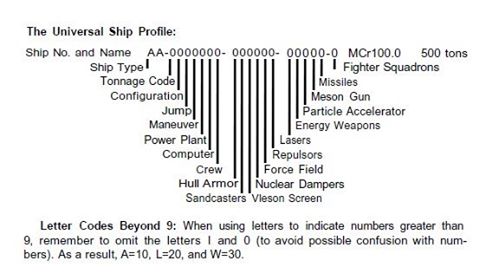Universal Ship Profile
The Universal Ship Profile (USP) or Imperial Ship Profile is a quick, universal code for ships or vessels.
- It is known in many places outside of the Third Imperium as the Universal Craft Profile or UCP.
Please refer to the following AAB Library Data for more information:
Starship:
- Advanced Ship Classifications
- Ship Mission Code / Supraclass
- Ship Type Code / Superclass
- Ship Class Code / Class
- Model (TL)
- Bloc (Lot)
- Basic Ship Classifications
- Adventure Class Ship (Auxiliary Class Ship)
- Battle Class Ship (Bulk / Subcapital Class Ship)
- Capital Ship (Capital Class Ship)
- Fleet Class Ship (Capital Class Ship)
- Size-Role Classification
- Subcapital Ship (Small & Large Battle Class Ships)
- QSP
- USP
- World Class Ship
- Astronomical Unit (AU)
- FTL
- Light Speed (c)
- Light-week (lw)
- Light-year (ly)
- NAFAL (STL)
- Parsec (pc)
- Naval Construction
- CBPUSAL (Hull)
- Imperial Ship Builders Association (ISBA)
- Naval Architect AKA Shipwright
- Quick Ship Design System (QSDS)
- Quick Ship Profile (QSP)
- Ship Equipment
- Ship Registry
- Ship's Papers
- Shipyard
- Standard Ship Design System (SSDS)
- Starport Authority (SPA)
- Trader's Guild
- Travellers' Naval Architecture Society (TNAS)
- Universal Ship Profile (USP)
Description (Specifications)
The Imperial Ship Profile is used by the Scout Service to classify ship mission and performance. All together, the ship's vital statistics are presented in one short record. The record is relatively brief and finer detail can be documented elsewhere in the data file.
Image Repository
USP Value Parameters
START BLOCK: 111334 Unicorn-S-
- Ship Registration #
- Ship Name (Named Ship)
- Ship Type Code (alphanumeric code: typically 2 to 4 characters)
BLOCK-1: 0000000
- Tonnage Code (Tn)
- Configuration (Hl) (CBPUSAL)
- Jump (J-?)
- Maneuver (M-?)
- Power Plant (P-?)
- Computer (Sc-?)
- Crew (C-?) (...excludes marines)
BLOCK-2: 000000
- Hull Armor (Ha-?)
- Sandcasters (Sc)
- Meson Screen (Ms)
- Nuclear Damper (Nd)
- Forcefield (Gb)
- Repulsor (Rp)
BLOCK-3: 00000-0
- Lasers (Ls)
- Energy Weapons (Ew)
- Particle Accelerators (Pa)
- Meson Guns (Mg)
- Missiles - (Ms)
- Fighter Squadrons (Fs)
END BLOCK: MCr14.5 100 tons
- MCr Cost
- Tonnage
NOTES: Ship registration numbers tend to be six alphanumeric characters in length, but some older or large production lot ships can greatly vary by local custom and manufacturer.
USP Information Blocks
One version consists of three blocks in this order:
- Ship mission codes
- One number or letter each for:
- Technology level
- Size modifier (...such as 4 for 40 tons or 40,000 tons)
- Size indicator (...such as 7 for 40 tons or A for 40,000 tons)
- Jump performance (...in parsecs per jump)
- Acceleration performance (...in Gs)
- Hull configuration
- One letter each to signal the presence of other features
- A: (heavily) Armed (..sometimes omitted if the mission code suggests it should be armed, or for light weapons such as a single laser turret on a free trader)
- C: Cold Sleep (...at least enough low berths to carry the entire crew)
- D: Long Duration (...extra supplies or stores, and/or the ability to manufacture its own)
- E: Energy Weapons (...not including spinal weapons)
- K: Kinetic Weapons (...not including missiles or spinal weapons)
- L: Lab
- M: Missile Weapons (...including torpedoes, not including spinal weapons)
- N: Nonhumanoid (...designed for crew with nonhumanoid body plans)
- P: rePair facilities (...adaptable to any ship that the ship's crew agrees to fix, whether or not the facilities are optimized toward a certain type of ship; ships only able to repair themselves and their own smallcraft do not count)
- R: all Robot crew (...possibly including biological androids but no sophont crew, whether or not the ship carries passengers and/or takes orders from a captain who may or may not usually be aboard; a sophont artificial intelligence crew would disqualify their ship from this code, but none are known to Charted Space as of 1105)
- S: Spinal Weapon
- X: eXperimental (...the opposite of a standard design: a ship class consisting of few examples, possibly just one; any AAB article about a ship with this code should be understood to be data on what the ship used to be like some time ago)
NOTES: Regardless of version, each position has a "factor" or value that represents an element of the ship. Common elements include hull displacement tons, hull configuration, computer type, weapons, screens, fighters and the number of crew.
A size modifier and indicator of 00 means something that is no more than 0.000001 tons. This is typically debris or small munition being individually tracked for some reason, or a tiny drone. Civilizations as early as TL-8 have been known to put up monitoring satellites this small. The Imperial planners who developed this standard decreed this as the smallest size worth distinguishing, based on measurement standards dating back to pre-spaceflight Terra.
History & Background (Dossier)
The usage of the USP in various formats can be traced well back to the First Imperium although scholars argue much of the research.
Once hop drive was discovered, with the observation that jump drive capped out at 9, jump performance codes A-J were reserved for hop drive (A = Hop-1 through J = Hop-9), K-T for whatever would come next after hop drive, and U-Z for any drives beyond that, skipping I and O as usual.
Selected USP examples
Examples include:
- MT C4831U LC : merchant transport, tech level 12, 400dt, jump 3, g 1, unstreamlined, cold sleepers, lab
- VCR C2A23S ADNS : vargr cruise strike, 20000dt, jump 2, g 3, streamlined, armed, long duration, nonhumanoid, spinal mount weapon
- FI F3704A EKM : fighter imperial, tech level 15, 30dt, 4g, airframed, energy, kinetic and missile weapons
References & Contributors (Sources)
- Marc Miller. Starships (Game Designers Workshop, 1977), TBD.
- Marc Miller, Frank Chadwick, John Harshman. High Guard (Game Designers Workshop, 1980), 52.
- Don Perrin. Starships (Imperium Games, 1996), TBD.
- Traveller Wiki Editorial Team
- Author & Contributor: Lord (Marquis) and Master of Sophontology Maksim-Smelchak of the Ministry of Science

